
The saying still holds true: You could hide a body on page 2 of Google, and no one would ever find it. That’s because over 90% of searchers stay on the first page, while less than 1% click on second-page results.
So, what should you do if your traffic still sucks despite your search engine optimization efforts? Though effective SEO is a long-term play, we’ve got the best SEO tips to immediately improve your page position.
Dig into these suggestions and use them to start rising through the rankings today.
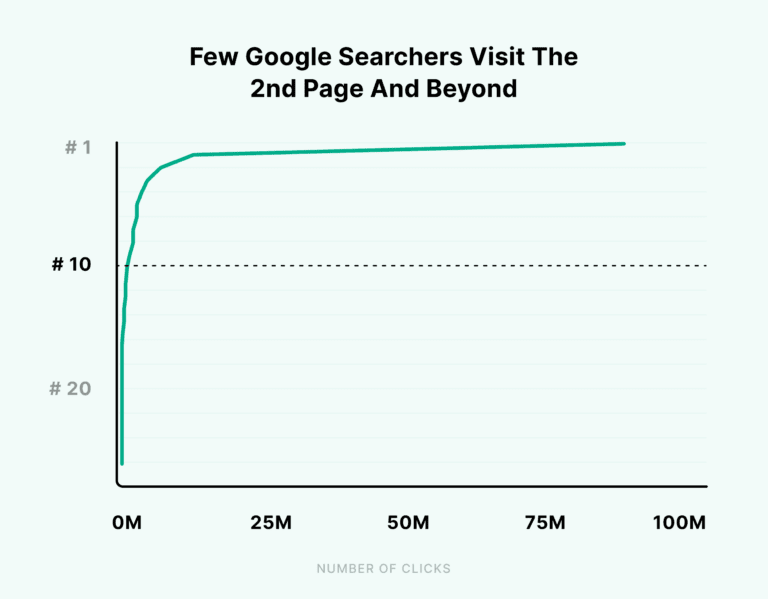
Image Source: Backlinko
Key Takeaways:
- Regularly written content for humans by humans always does the best in rankings.
- Focus on quality keywords and best practices for title tags, meta descriptions, URLs, and headings.
- Optimize technical aspects of your site, such as image quality and your site’s user experience.
- Perform competitor analyses and reoptimize nonperforming posts to get a bump in search engine results.
- Encourage social sharing of your content and apply good link-building practices.
1. Put Organic Content Creation Above Technical SEO Tips
We can’t emphasize this enough: Create content that appeals to humans. High-quality material should always be your number one goal.
Sure, SEO best practices encourage search engine crawlers to index your site well. Even so, it’s real people who are going to comment on, link to, and share your value-driven content, providing that desired competitive edge.
So, when writing articles, think about what will truly bring value to your readers (the humans!), then look at how you can optimize it for the robots with technical SEO tips.
Actually, today’s search engines are even smart enough to tell whether you designed your content simply to manipulate the rankings. At the same time, they’ll identify and reward content that people will value.
Here are ways you can create interesting, valuable content:
Show Your Personality
Be yourself and be original. At MIG, we’re not afraid to step on a few toes in our blog by getting a little snarky and calling out ideas and practices that are wrong or just outright dumb. 
With so many choices for buyers, you have to give them more reason to connect with you than a low price and good service. Stand out with a clear take on things and a defined personality.
Use these excellent tips on improving your writing if you’re hesitant:
Write About What People Care About
This suggestion might seem like a big “duh” in our SEO tips, but many professionals tend to share what they think an audience should hear instead of what people really want to know.
Look for topics that stir your readers and are practical for their everyday lives. You can do that even if you’re in a “boring” industry by writing about shoulder niches.
For example, what if you run a cleaning business? Blogs about hiring a cleaner will get stale and too self-promotional.
However, you can discuss physical wellness, mental health, and parenting topics. All of these relate in one way or another to having a clean home or office and will get more views.
Finally, write “evergreen” content that delivers long-term value. Leave your commentary on breaking news and seasonal subjects mainly to social media (where you can connect how a previous blog pertains to a current event).
2. Work on the Quality of Your Keywords
You can’t have an article on SEO tips without discussing keywords! Are you targeting the right ones?
Find the Right Keywords and Topics
We suggest identifying the expressions you want to rank for and plugging those terms into search engines. Then, look at what the competition is on the results page.
Next, use Google Ads Keyword Planner to look for the broad match keyword variations. As you create content, use one main key phrase per page.
For maximum results, use a keyword research tool like BrightEdge or Ahrefs. A good program gives you helpful keyword recommendations, search volumes, rankings for difficulty, and how many clicks you can anticipate for each suggestion.
If you have a newer site or don’t already have a strong page, use long-tail keywords and choose the “low-hanging fruit.” These lower-volume keywords are going to be easier to rank for.
Remember to use your primary keyword in your article introduction and call to action, as well as regularly throughout your content. (Placing the word or phrase every 100-200 words is ideal.)
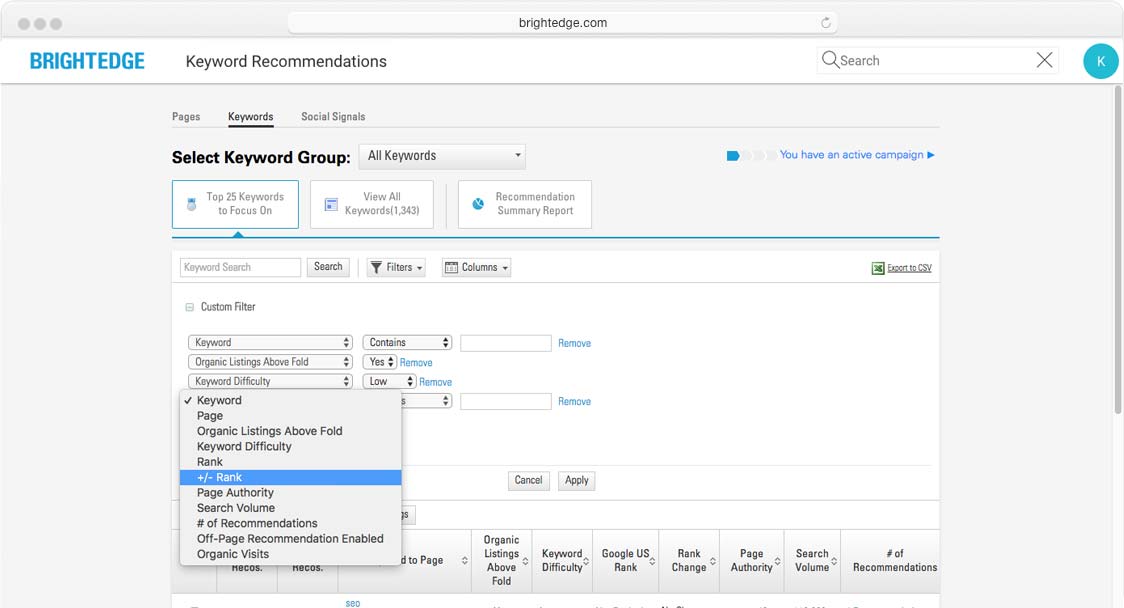
Image Source: Brightedge.com
Avoid Search Homonyms
Another one of the critical keyword SEO tips is to look out for “search homonyms,” which are vague terms that could refer to various different and unrelated things. (A great example is the word “apple,” which could be the tech brand or the delicious fruit.)
When selecting keywords, get as specific as possible and avoid confusing homonyms that might negatively affect your search rankings. Once you have your list, categorize them according to pain points or your buyer personas and create a content calendar.
Use Appropriate Secondary Keywords
Various secondary keywords support your main topic and help Google understand your article’s focus. Sprinkle related terms and semantic variations of your primary keyword throughout your post.
As with your primary keyword, don’t force these words and phrases into your content. Instead, use them naturally in the topic.
Create Effective Branded Keywords
Here’s one of our advanced SEO tips: If you want a keyword that is a guaranteed winner, try to create branded phrases that you will surely rank for. If your company name or tagline is catchy, these can be great choices.
However, you can use anything uniquely yours and part of your brand. A product, process, or motivating phrase can catch fire and serve as a perfect branded keyword.
For example, Dave Ramsey started a movement with his “Baby Steps” to financial stability. Type in “baby steps,” and he’s at the top, above anything to do with kids learning to walk.
In your case, you have a better chance by coining terms with unique spellings or meanings that can gain traction. You’ll likely have to make multiple attempts before you find something that sticks, but the benefits are well worth the effort.
3. Designate Which Pages Google Bots Can Ignore
According to SEO Hacker founder Sean Si, you have a limited “crawl budget.” The Google bots can’t spend all day, every day, crawling every page on your site.
Surely, you have pages you definitely want on search engine results pages, like compelling content that generates excellent leads. On the other hand, your About Me and Checkout pages don’t need to appear in results because they aren’t likely to bring in organic traffic.
What SEO tips can help? Go into your robots.txt file and put a noindex/nofollow tab on those pages you don’t want to index.
Also, don’t put quantity over quality. You should delete “zombie” pages that don’t offer useful information and get no traffic.
When Google sees a lot of low-quality content on a site, it will drop your ranking. So trim the fat and boost your visibility.
4. Refine Title Tags
Creating rock-solid title tags for your web pages and blog posts is one of the most important SEO tips influencing your Google ranking. It’s your title tag that displays in search results, so always include a fitting long-tail keyword.
In addition, keep your title tags to 50-60 characters for optimal length but don’t sacrifice clarity. We find that your title tags should be easy for Google to find and rank, but they should also be easy for people to understand.
Remember: You’re writing for humans, not for robots! Someone might decide to click or skip you solely on the impact of your title tag.
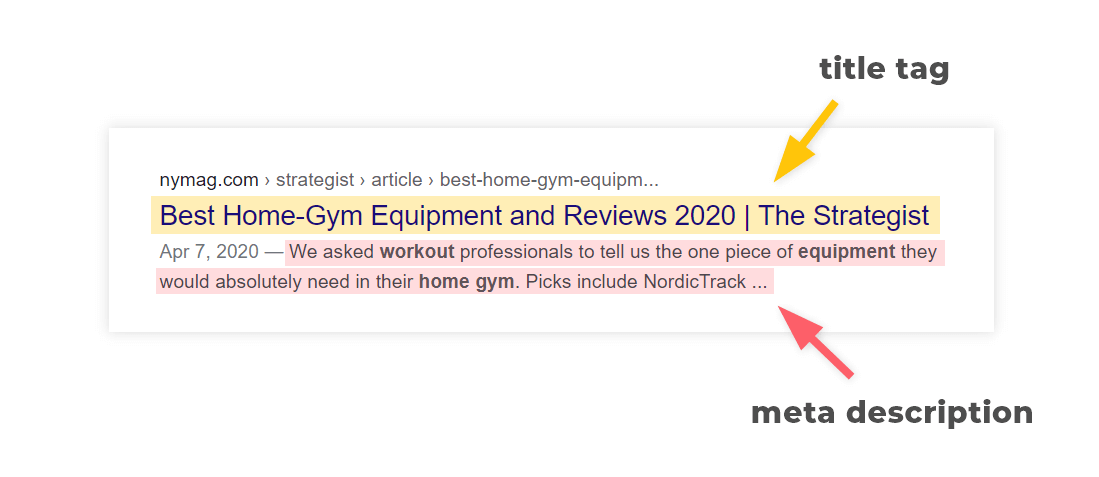
Image Source: Mangools.com
5. Write Meta Descriptions That Encourage Clicks
The meta description is the line of text that appears below your titles or headings in search results. The length that Google displays keeps varying, but keep them under 160 characters as a best practice.
While meta descriptions do not directly impact rankings, they help searchers see if they have found what they are looking for and encourage clicks to your pages. Make your meta descriptions compelling and include variations of your keywords anyway.
6. Use Headings Intelligently
What do headings have to do with practical SEO tips? They help Google understand what to expect in the following sections of your content, so make sure you optimize your H2 and H3 headings for SEO.
Be sure to include your keywords in some of these lines. This helps Google see that the content under a heading will be covering the same topic as your keywords.
In our experience, we’ve found that headings can also keep users on your site. A wall of text is difficult to read, but abundant headings, subheadings, and bullets break up your article into digestible chunks.
Plus, when you answer vital questions under headings, Google is more likely to use your post for a featured snippet. Snippets sit in the top spot on the page above all other results – prime real estate!
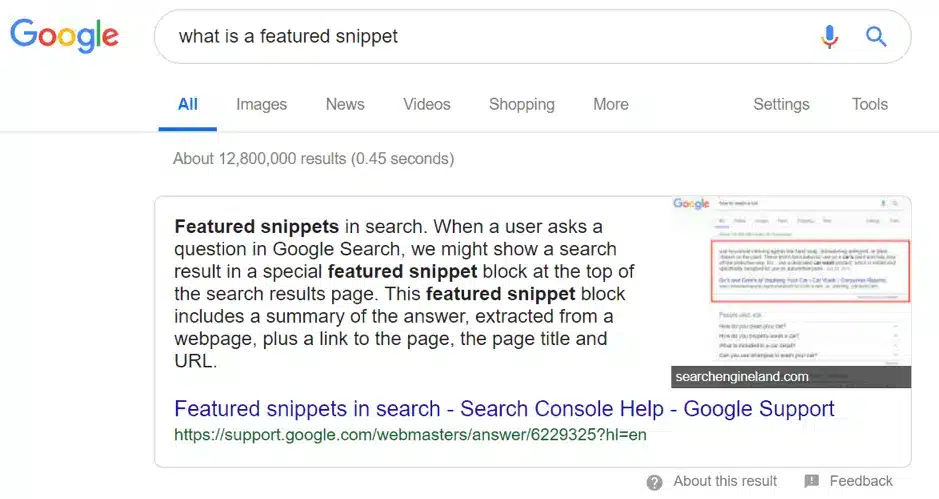
Image Source: Marketing Insider Group
7. Improve Your URLs
SEO tips for URLs will always tell you to be brief and descriptive. Make sure your URLs include keywords relevant to your business and that your audience will likely search for.
Further, leave out low-value stop words, such as “and,” “or,” and “the.” These words add clutter, make your URLs more spammy-looking, and slow down your indexing.
Optimizing your URLs may also involve improving your site structure. Follow a proper hierarchy to build a powerful site that boosts your search rankings.
8. Optimize Your Images
The best blogs include images and video links, but don’t go throwing these into your posts aimlessly. Format and contextualize visuals correctly for maximum effect with the following SEO tips.
Alt Text
Adding alt text to images doesn’t just improve the accessibility of your content for those with vision impairments. This step also tells Google what the images are.
Google can’t “see” images (yet…  ) and can only read text. Supplying keyword-rich alt text helps Google “read” your images, which improves your SEO.
) and can only read text. Supplying keyword-rich alt text helps Google “read” your images, which improves your SEO.
Effective alt text is about being descriptive and short but not spammy. Alt text should contain your target keywords and phrases relevant to your content, as well as the context and purpose of the image in less than 125 characters.
Proper Formatting and Location
Your images and videos should sit on the page in context with the surrounding text. Don’t leave readers guessing the reason for a visual.
Also, pictures that are too large or small for the page will influence their effectiveness and readability, so learn how to use software to do some simple resizing when necessary. Be particularly careful that a picture still looks good on mobile.
The file size shouldn’t be too large, either. A huge file can slow down your page, killing your SEO.
9. Link to Good Internal and External References
Following smart SEO tips about linking enhances your credibility and improves your ranking. The reason is that linking your content to other sites with domain authority shows Google that you are providing good, valuable information to readers.
However, don’t just add as many links as you can. You might end up making your content seem spammy, which diminishes its credibility.
Also, irrelevant or low-quality links make your content look like it is trying to manipulate the search engine rankings. Always include high-quality links that are relevant to the topic of your content and that your readers will find useful.
Use the same strategy to link to your own articles even more liberally than you do to outside sources. Just remember that the links should be pertinent and practical for your readers.
10. Encourage Social Sharing
While Google may not use social sharing in their search algorithms, it doesn’t mean you can’t take advantage of social media SEO tips. Google tracks (aka crawls) these sites as well and will see any content that you share.
In any case, social sharing drives your brand awareness, moving more potential customers and prospects to search for your company. This increased activity signals Google to give greater weight to your content, benefitting your search rankings.
Use these social SEO tips to boost shares:
- Make it easier for people to share your content by adding social sharing buttons to your blogs.
- Ask your audience directly to share your content, but don’t do this for every single post since it can feel spammy and overly self-promotional.
- Visual media drives social engagement and sharing, so add compelling images to your long-form content and posts.
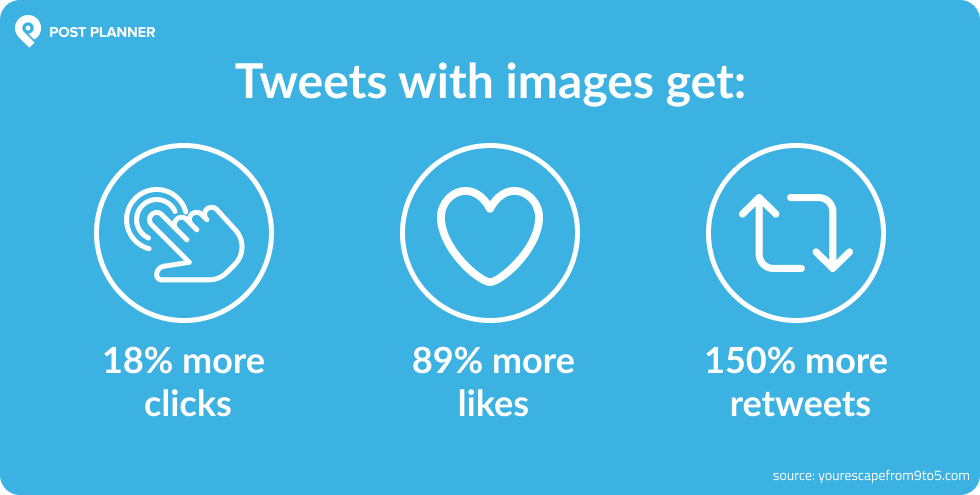
Image Source: Post Planner
Remember to cross-promote your content on multiple channels to increase your reach and sharing. Tailor your messaging for each channel, as every platform serves a unique audience with different goals and desires.
11. Test Your Site’s User Experience
UX is essential for optimizing your site. A fast-loading, clearly laid-out, well-maintained domain is going to keep visitors on your site longer and make it more appealing for both searchers and search engines.
Use the following SEO tips for improving your site’s UX:
- Check for error pages and fix broken links.
- Check your site’s speed and eliminate anything slowing you down, such as unnecessary scripts or plugins.
- Optimize everything on your site for the mobile experience.
- Have an outside party evaluate your design if your bounce rate is too high.
Take incremental steps to make your site as smooth and easy to navigate as possible.
12. Reoptimize Existing Poorly Performing Content
What’s the easiest SEO tip for increasing organic traffic, you ask? Start with reoptimizing the existing content on your website that isn’t performing up to snuff.
Google Analytics allows you to see the traffic each page on your website is receiving, and you can even compare different periods in time. Review the pages on your website and pick out a few of your top content pieces that aren’t getting the views they deserve.
What SEO tips should you use to reoptimize these pieces? Try these ideas:
- Add new sections of content with updated information.
- Refresh existing content sections with new keywords.
- Make pieces easier to read by including H2 and H3 subheadings.
- Add new images.
- Update image alt text with new descriptions.
When we update our blogs for our clients or our own site, we see a juicy little bump in the rankings.
13. Perform In-Depth Competitor Analysis
Competitor analyses are great tools to isolate which SEO tips you should focus on. By taking a look at your competition, you’ll be able to see exactly what you need to do to beat them.
Ask yourself and your team: “What types of content are competitors creating? What topics do they cover? Can we create a better, more valuable resource?”
Solid research also gives you a bar for measuring the success of your own content. SEMrush is an awesome tool for competitive analysis to boost organic search visibility:
While your competition provides valuable insights, it’s also critical to make sure the content you create after doing this research is completely unique. Search engines will find duplicate content on your site and penalize you for it.
14. Blog Consistently and Often
What are our favorite SEO tips? You guessed it: Make sure you’re consistently publishing new content on your blog and doing so as often as possible to gradually improve your website’s SEO.
We’ve discovered that most companies see the highest ROI for lead conversions when they post a new blog daily. If you lack the resources to do so, start with once per week.
(Any less than that, and your readers may forget about your blog.)
Believe it or not, blogging isn’t just about creating content for your audience. In fact, Google itself loves fresh, relevant content, especially when you include keywords.
If your website has stayed the same for years, these SEO tips are even more vital. Regular blogging allows you to reestablish your business as a thought leader, convert visitors into new leads, and provide new and interesting content for Google to index.
15. Actively Seek Guest Posting Opportunities
Guest posting is a great way to increase traffic to your website, build your brand, and win great backlinks to content on your own pages. If you don’t quite know how to get started with guest posting, you’re not alone!
The process can go like this:
- Find blogs: Search for keywords you want to rank for or that are relevant to your industry along with the terms “guest blog,” “contributor,” or “write for us.” Then, the SERPs will show you a list of blogs that are great candidates for your guest posts.
- Craft your pitch: The most important thing is to ensure that the topic of the post you want to pitch is relevant and interesting to the target blog’s audience. You also need to communicate that you’re going to provide value and not be a pitch machine.
- Start writing: Use the SEO tips you’ve learned here to create a high-quality article. Don’t forget to link to your own relevant content and include an author bio, too.
You can try other techniques for finding ideal blogs. For example, you can search for the name of someone in your field who posts regularly and use the terms above to find sites they’ve written for.
Another sneaky tip is to do a reverse image search for a common contributor’s headshot. The results will give you all kinds of blogs to pitch!
Plus, don’t forget the old quid pro quo, where you can invite guest bloggers to your site and you post on theirs. (Just be sincere and work with people who have value for your audience.)
16. Pursue High-Quality Backlinks
Links back to your content from reputable sites are a valuable endorsement that Google appreciates. However, this tactic can be one of the trickiest SEO tips to employ.
The following strategies could help you earn more backlinks and increase your ranking:
- Publish a long-form industry study full of great data.
- Create your own high-quality images, such as charts, graphs, and infographics.
- Seek out podcast interviews and speaking opportunities the same way you do for guest posts.
- Join professional associations or networking groups to get into industry directories.
Dedicate a portion of your time to generating backlinks from high-authority sites but don’t fret too much over this technique. Instead, focus most on implementing the SEO tips where you have control.
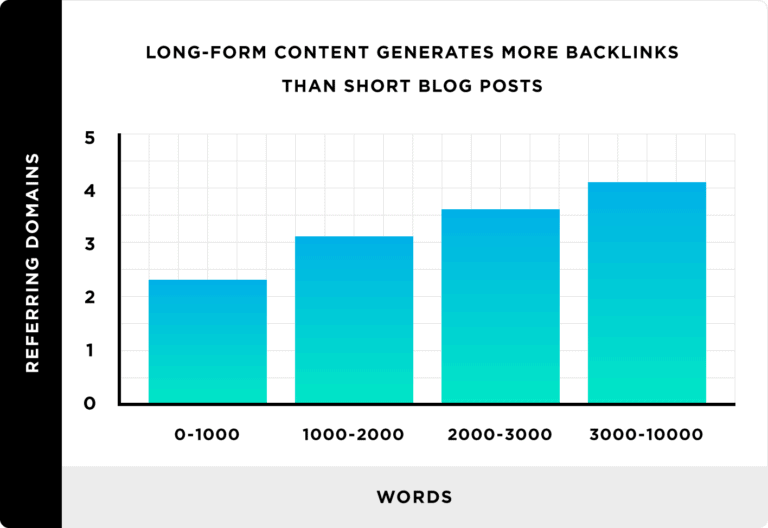
Image Source: Backlinko
17. Keep Learning New SEO Tips To Improve
Once you’ve implemented all of these SEO tips, you’re still not done. You can always learn more as Google adjusts its algorithm, which changes which SEO techniques we should use and how to use them.
Plus, there are always ways to improve what you’ve already done. Persistence helps you get on top and stay on there as your competitors nip at your heels.
If you want to start seeing results sooner than later and need help putting these SEO tips into practice, talk to our crack team at MIG. We’ll help you come up with a content marketing plan that’s second to none!


0 Commentaires